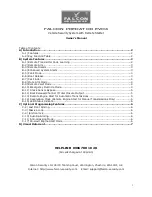
D200-09-00
1
I56-1986-000
7251A Intelligent Laser Smoke Sensor
INSTALLATION AND MAINTENANCE INSTRUCTIONS
Before Installing
This sensor must be installed in compliance with the con-
trol panel system installation manual. The installation must
meet the requirements of the Authority Having Jurisdiction
(AHJ). Sensors offer maximum performance when installed
in compliance with CAN/ULC S524.
General Description
Model 7251A is a plug-in type smoke sensor that uses a
laser based sensing chamber. The sensor uses analog-
addressable communications to transmit smoke density
and other information to the control panel. Rotary-decade
switches are provided for setting the sensor’s address. Two
LEDs on the sensor are controlled by the panel to indicate
sensor status. An output is provided for connection to an
optional remote LED annunciator (P/N RA400Z).
This detector requires compatible addressable com-
munications to function properly. Connect this sensor
to listed-compatible control panels only.
Spacing
System Sensor recommends spacing sensors in compli-
ance with CAN/ULC S524. In low air flow applications with
smooth ceilings, space sensors 30 feet apart. For spe-
cific information regarding sensor spacing, placement, and
special applications, refer to CAN/ULC S524 or the System
Sensor
Guide For Proper Use of System Smoke Detectors
,
available from System Sensor (P/N I56-407-XX).
Wiring Instructions
Specifications
Operating Voltage Range:
15 to 32 VDC
Standby Current:
330
µ
A
@ 24 VDC (one
communication every 5 sec. with LED blink enabled)
Max. Alarm Current (LED on:)
6.5 mA @ 24 VDC
Operating Humidity Range:
10% to 93% Relative Humidity, noncondensing
Operating Temperature Range:
0°C to 38°C (32°F to 100°F)
Height:
1.7 inches (43 mm) installed in B210LPA Base
Diameter:
6.1 inches (155 mm) installed in B210LPA Base
4.1 inches (104 mm) installed in B501A Base
Weight:
5.0 oz. (142 g)
Additional Bases Available:
All 200/500 Series bases are compatible.
All wiring must be installed in compliance with the Canadian
Electrical Code, applicable local codes, and any special
requirements of the Authority Having Jurisdiction. Proper
wire gauges should be used. The installation wires should
be color-coded to limit wiring mistakes and ease system
troubleshooting. Improper connections will prevent a sys-
tem from responding properly in the event of a fire.
Remove power from the communication line before
installing sensors.
All wiring must conform to applicable local codes, ordi-
nances, and regulations.
1. Wire the sensor base (supplied separately) per the wir-
ing diagram, see Figure 1.
2. Set the desired address on the sensor address switch-
es, see Figure 2.
3. Install the sensor into the sensor base. Push the sensor
into the base while turning it clockwise to secure it in
place.
4. After all sensors have been installed, apply power to the
control unit and activate the communication line.
5. Test the sensor(s) as described in the TESTING section
of this manual.
6581 Kitimat Rd., Unit #6, Mississauga, Ontario, L5N 3T5
1-800-SENSOR2, FAX: 905-812-0771
www.systemsensor.ca






















